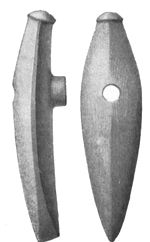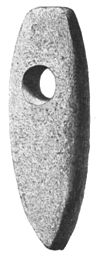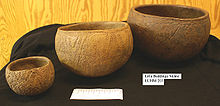- Corded Ware culture
-
 Approximate extent of the Corded Ware horizon with adjacent 3rd millennium cultures (after EIEC).
Approximate extent of the Corded Ware horizon with adjacent 3rd millennium cultures (after EIEC).
The Corded Ware culture (ca. 2900–2450/2350 cal. BCE),[1] alternatively characterized as the Battle Axe culture or Single Grave culture, is an enormous European archaeological horizon that begins in the late Neolithic (Stone Age), flourishes through the Copper Age and culminates in the early Bronze Age.
Corded Ware culture is associated with some of the Indo-European family of languages by many scholars and believed to be related to the Catacomb culture.
Around 2400 BCE the people of the Corded Ware replaced their predecessors and expanded to Danubian and Nordic areas of western Germany. One related branch invaded Denmark and southern Sweden, while the mid-Danubian basin, though showing more continuity, shows also clear traits of new Indo-European elites (Vučedol culture).
 Boat-shaped battle axe from Närke
Boat-shaped battle axe from Närke
Contents
Extent
It encompassed most of continental northern Europe from the Rhine River on the west, to the Volga River in the east, including most of modern-day Germany, Netherlands, Denmark, Poland, Lithuania, Latvia, Estonia, Belarus, Czech Republic, Slovakia, northern Ukraine, European part of Russia, as well as coastal Norway and the southern portions of Sweden and Finland.
The contemporary Beaker culture overlapped with the western extremity of this culture, west of the Elbe, and may have contributed to the pan-European spread of that culture. Although a similar social organization and settlement pattern to the Beaker were adopted, the Corded Ware group lacked the new refinements made possible through trade and communication by sea and rivers.[2]
Nomenclature
It receives its name Corded Ware from the ornamentation of its characteristic pottery, Single Grave from its burial custom, and Battle Axe from its characteristic grave offering to males, a stone battle axe (which was by this time an inefficient weapon but a traditional status symbol).
Origins and development
There have been many different views concerning the origin of the Corded Ware culture. There is broadly a division between archaeologists who see an influence from pastoral societies of the steppes north of the Black Sea and those who think that Corded Ware springs from central Europe. In both camps, there are many differing views. The recent tendency has been to seek a middle way. The distribution of the Corded Ware Culture coincides in part with the earlier Funnel Beaker Culture, with which it shares a number of features, such as cord impressions on pottery, and the use of horses and wheeled vehicles, that can be ultimately traced to the cultures of the European steppe.[3]
In places a continuity between Funnel Beaker and Corded Ware can be demonstrated, whereas in other areas Corded Ware heralds a new culture and physical type.[4] On most of the immense, continental expanse that it covered, the culture was clearly intrusive, and therefore represents one of the most impressive and revolutionary cultural changes attested by archeology.[2] The degree to which cultural change generally represents immigration is a matter of debate, and such debate has figured strongly in discussions of Corded Ware.
Corded Ware ceramic forms in single graves develop earlier in Poland than in western and southern Central Europe.[5] The earliest radiocarbon dates for Corded Ware come from Kujavia and Małopolska in central and southern Poland and point to the period around 3000 BC. Carbon-14 dating of the remaining central European regions shows that Corded Ware appeared after 2880 BC[3] It spread to the Lüneburger Heide and then further to the North European Plain, Rhineland, Switzerland, Scandinavia, the Baltic region and Russia to Moscow, where the culture met with the pastoralists considered indigenous to the steppes.[2]
In the western regions this revolution has been proposed to be a quick, smooth and internal change that occurred at the preceding Funnelbeaker culture, having its origin in the direction of eastern Germany.[6] Whereas in the area of the present Baltic states and Kaliningrad Oblast (former East Prussia), it is seen as an intrusive successor to the southwestern portion of the Narva culture.
In summary, Corded Ware does not represent a single monolithic entity, but rather a diffusion of technological and cultural innovations of different, contemporaneous peoples, living in close proximity to each other and leaving different archaeological remains.
Economy
There are very few discovered settlements, which led to the traditional view of this culture as exclusively nomadic pastoralists. However this view was modified, as some evidence of sedentary farming emerged. Traces of Emmer wheat, bread wheat and barley were found at a Corded Ware site at Bronicice in south-east Poland. Wheeled vehicles (presumably drawn by oxen) are in evidence, a continuation from the Funnelbeaker culture era.[4]
Domesticated animals included horses, oxen and cattle. Cows' milk was used systematically from 3400 BC onwards in the northern Alpine foreland. Sheep were kept more frequently in the western part of Switzerland due to the stronger Mediterranean influence. Changes in slaughter age and animal size are possibly evidence for sheep being kept for their wool at Corded Ware sites in this region.[7]
In the circum-Baltic and more westwards coastal Scandinavian areas, there is clear evidence of a maritime economy, where the sea has to be seen as a uniting element.
Graves
Inhumation occurred under flat ground or below small tumuli in a flexed position; on the continent males lay on their right side, females on the left, with the faces of both oriented to the south. However, in Sweden and also parts of northern Poland the graves were oriented north-south, men lay on their left side and women on the right side - both facing east. Originally, there was probably a wooden construction, since the graves are often positioned in a line. This is in contrast with practices in Denmark where the dead were buried below small mounds with a vertical stratigraphy: the oldest below the ground, the second above this grave, and occasionally even a third burial above those. Other types of burials are the niche-graves of Poland. Grave goods for men typically included a stone battle-axe. Pottery in the shape of beakers and other types are the most common burial gifts, generally speaking. These were often decorated with cord, sometimes with incisions and other types of impressions.
 Late battle axe from Gotland
Late battle axe from Gotland
The approximately contemporary Beaker culture had similar burial traditions, and together they covered most of Western and Central Europe. While broadly related to the Corded Ware culture, the origins of the Bell-Beaker folk are considerably more obscure, and represent one of the mysteries of European pre-history.
In April 2011, it was reported that a deviant Corded Ware burial had been discovered in a suburb of Prague.[8] The remains, believed to be male, were orientated in the same way as womens' burials and were not accompanied by any gender-specific grave goods. The excavators suggested the grave may have been that of a "member of a so-called third gender, which were people either with different sexual orientation or transsexuals or just people who identified themselves differently from the rest of the society",[8] while media reports heralded the discovery of the world's first "gay caveman".[9][10] Archaeologists and biological anthropologists criticised media coverage as sensationalist. "If this burial represents a transgendered individual (as well it could), that doesn't necessarily mean the person had a 'different sexual orientation' and certainly doesn't mean that he would have considered himself (or that his culture would have considered him) 'homosexual,'" anthropologist Kristina Killgrove commented. Other items of criticism were that someone buried in the Copper Age was not a "caveman" and that identifying the sex of skeletal remains is difficult and inexact.[11] A detailed account of the burial has not yet appeared in the scientific literature.
Language
In the 19th century the Corded Ware culture was favoured by some authors as the Urheimat (original homeland) of the speakers of the Proto-Indo-European language, a theory that has been discarded by modern science in favor of the Kurgan hypothesis or the Renfrew NDT. Still it is generally held that:[12]
"...Celtic, Germanic, Baltic and Slavic may possibly be traced back to the Corded Ware horizon of north, central and eastern Europe."However this is not to suppose that all of these proto-languages actually arose during the period of the Corded Ware horizon, across its whole territory, or exclusively within its confines. The Proto-Germanic language for example is deduced have developed in Scandinavia towards the end of the Nordic Bronze Age. See also Proto-Balto-Slavic language and Proto-Celtic language.
Subgroups
Corded Ware culture
The prototypal Corded Ware culture, German Schnurkeramikkultur is found in Central Europe, mainly Germany and Poland, and refers to the characteristic pottery of the era: twisted cord was impressed into the wet clay to create various decorative patterns and motifs. It is known mostly from its burials, and both sexes received the characteristic cord-decorated pottery. Whether made of flax or hemp, they had rope.
Single Grave culture
General term used to refer to a series of late Neolithic communities of the 3rd millennium BC living in Scandinavia, northern Germany, and the Low Countries that share the practice of single burial under barrows, the deceased usually being accompanied by a battle-axe, amber beads, and pottery vessels. The cultural emphasis on drinking equipment already characteristic of the early Funnelbeaker culture, reappeared with the spread of Corded Ware traditions. Especially in the west (Scandinavia and northern Germany), the drinking vessels have a protruding foot and define the Protruding-Foot Beaker culture (PFB) as a subset of the Single Grave culture.[13] The Bell Beaker culture has been proposed to derive from this specific branch of the Corded Ware culture.
Swedish-Norwegian Battle Axe culture
 Pottery from Lilla Beddinge cemetery in Skåne, Sweden
Pottery from Lilla Beddinge cemetery in Skåne, Sweden
The Swedish-Norwegian Battle Axe culture, or the Boat Axe culture, appeared ca. 2800 BC and is known from about 3000 graves from Skåne to Uppland and Trøndelag. While amateur historian Herman Lindquist has referred to this as the "Age of crushed skulls" there is no indication that this was an especially violent time, and most of the "crushing" happened post-mortem in the ground. The "battle-axes" were primarily a status object. There are strong continuities in stone craft traditions, and very little evidence of any type of full-scale migration, least of all a violent one. The old ways were discontinued as the corresponding cultures on the continent changed, and the farmers living in Scandinavia took part in those changes since they belonged to the same network. Settlements on small, separate farmsteads without any defensive protection is also a strong argument against the people living there being aggressors. Recently also the mixture of this culture with Barbed Wire Beaker culture elements from the west that reached until Sweden in the Late Neolithic, probably ultimately derived from the same Corded Ware stock, has come into the picture.[14]
About 3000 battle axes have been found, in sites distributed over all of Scandinavia, but they are sparse in Norrland and northern Norway. Less than 100 settlements are known, and their remains are negligible as they are located on continually used farmland, and have consequently been plowed away. Einar Østmo reports sites inside the Arctic Circle in the Lofoten Islands, and as far north as the present city of Tromsø.
The Swedish-Norwegian Battle Axe culture/Boat Axe culture was based on the same agricultural practices as the previous Funnelbeaker culture, but the appearance of metal changed the social system. This is marked by the fact that the Funnelbeaker culture had collective megalithic graves with a great deal of sacrifices to the graves, but the Battle Axe culture has individual graves with individual sacrifices.
A new aspect was given to the culture in 1993, when a death house in Turinge, in Södermanland was excavated. Along the once heavily timbered walls were found the remains of about twenty clay vessels, six work axes and a battle axe, which all came from the last period of the culture. There were also the cremated remains of at least six people. This is the earliest find of cremation in Scandinavia and it shows close contacts with Central Europe.
In the context of the entry of Germanic into the region, Einar Østmo emphasizes that the Atlantic and North Sea coastal regions of Scandinavia, and the circum-Baltic areas were united by a vigorous maritime economy, permitting a far wider geographical spread and a closer cultural unity than interior continental cultures could attain. He points to the widely disseminated number of rock carvings assigned to this era, which display "thousands" of ships. To sea-faring cultures like this one, the sea is a highway and not a divider.
Finnish Battle Axe culture
The Finnish Battle Axe culture was a mixed cattle-breeder and hunter-gatherer culture, and one of the few in this horizon to provide rich finds from settlements.
Middle Dnieper and Fatyanovo-Balanovo cultures
- Main articles: Middle Dnieper culture and Fatyanovo-Balanovo culture.
The eastern outposts of the Corded Ware culture are the Middle Dnieper culture and on the upper Volga, the Fatyanovo-Balanovo culture. The Middle Dnieper culture has very scant remains, but occupies the easiest route into Central and Northern Europe from the steppe. If the association of Battle Axe cultures with Indo-European languages is to prove correct, then Fatyanovo would be a culture with an Indo-European superstrata over a Uralic substrata, and may account for some of the linguistic borrowings identified in the Indo-Uralic thesis.
See also
References
- ^ Baldia, Maximilian O (2006). "The Corded Ware/Single Grave Culture". http://www.comp-archaeology.org/CordedWare.htm.
- ^ a b c Cunliffe, Barry (1994). The Oxford Illustrated Prehistory of Europe. Oxford University Press. pp. 250–254.
- ^ a b Czebreszuk, Janusz (2004). Crabtree, Pam; Bogucki, Peter. eds. Ancient Europe, 8000 B.C. to A.D. 1000: An Encyclopedia of the Barbarian World.
- ^ a b Mallory, JP (1997). "Corded Ware Culture". In Dearborn, Fitzroy. Encyclopedia of Indo-European Culture.
- ^ Furholt, Martin (2004) (in German). Entstehungsprozesse der Schnurkeramik und das Konzept eines Einheitshorizontes. 34. Archäologisches Korrespondenzblatt. pp. 479–498. ISSN 0342-734X. http://web.rgzm.de/319.html.
- ^ Bloemers, JHF; van Dorp, T (1991) (in German), Pre- & protohistorie van de lage landen, onder redactie, De Haan/Open Universiteit, ISBN 90-269-4448-9
- ^ Schibler, J (2006). "The economy and environment of the 4th and 3rd millennia BC in the northern Alpine foreland based on studies of animal bones <". Environmental Archaeology 11 (1): 49–64.
- ^ a b "Ancient burial site unearthed in Prague". PressTV. 6 April 2011. http://www.presstv.ir/detail/173456.html. Retrieved 8 April 2011.
- ^ "First homosexual caveman found". The Telegraph. 6 April 2011. http://www.telegraph.co.uk/news/newstopics/howaboutthat/8433527/First-homosexual-caveman-found.html. Retrieved 8 April 2011.
- ^ "The oldest gay in the village: 5,000-year-old is 'outed' by the way he was buried". Daily Mail. 8 April 2011. http://www.dailymail.co.uk/sciencetech/article-1374060/Gay-caveman-5-000-year-old-male-skeleton-outed-way-buried.html?ito=feeds-newsxml. Retrieved 8 April 2011.
- ^ Pappas, Stephanie (7 April 2011). "'Gay Caveman' Story Overblown, Archaeologists Say". http://www.livescience.com/13620-gay-caveman-story-overblown.html. Retrieved 8 April 2011.
- ^ The Oxford Introduction to Proto-Indo-European and the Proto-Indo-European World. Oxford University Press. 2006. p. 452.
- ^ Sherratt, Andrew (1996). Fagan, Brian M. ed. The Oxford Companion to Archaeology. Oxford University Press. pp. 89, 217. ISBN 0-19-507618-4.
- ^ Vandkilde, Helle (2005). "A Review of the Early Late Neolithic Period in Denmark: Practice, Identity and Connectivity". Aarhus. http://www.jungsteinsite.uni-kiel.de/pdf/2005_vandkilde_low.pdf.
Sources
- Østmo, Einar (1996). The Indo-European Question: a Norwegian perspective. In Huld, Martin E; Jones-Bley, Karlene. "The Indo-Europeanization of Northern Europe". Journal of Indo-European Studies Monograph (Washington, DC: Institute for the Study of Man) (17): 23–41.
- Lindquist, H (1993) (in Swedish). Historien om Sverige.
Neolithic Europe (including the Chalcolithic) ↑ Mesolithic Europe ↑ Horizons Cultures Baden culture · Beaker culture · Boian culture · Chasséen culture · Cortaillod culture · Cucuteni-Trypillian culture · Dudeşti culture · Funnelbeaker culture · Gaudo culture · Globular Amphora culture · Hamangia culture · Karanovo culture · Lengyel culture · Pitted Ware culture · Pfyn culture · Rössen culture · Seine-Oise-Marne culture · Starčevo-Kőrös-Criş culture · Tisza culture · Tiszapolgár culture · Varna culture · Vinča culture · Vučedol culture · Wartberg culture · Windmill Hill cultureMonumental architecture Bank barrow · Causewayed enclosure · Cursus · Dolmen · Henge · Megalith · Rondel · Round barrow · Statue menhir · Stone circle · Timber circle · Tor enclosureTechnology Concepts ↓ Bronze Age Europe ↓ Categories:- Archaeological cultures
- Neolithic Europe
- Bronze Age Europe
- Copper Age Europe
- Encyclopedia of Indo-European Culture
- Indo-European
- Pre-Viking Scandinavia
Wikimedia Foundation. 2010.
